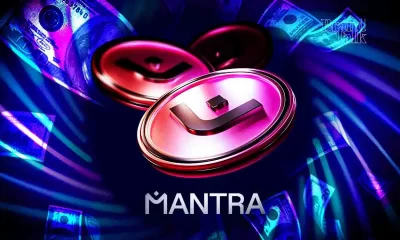Decentralization
Using Mining To Create More Fully Validating Bitcoin Users
Published
3 months agoon
By
admin

Bitcoin’s value proposition relies on its ability to resist any type of censorship. Without that feature, Bitcoin loses its power to challenge and resist any authority that wants to subjugate Bitcoin to the same rules that apply in the traditional world. With this in mind, it’s paramount that bitcoin has no central points of failure whatsoever. If there is a gatekeeper, there is a vulnerability. If there is a vulnerability, it will be exploited. And at that point, Bitcoin as an exercise of free and decentralized digital money simply stops.
To ensure the network’s decentralization, robustness and anti-fragility, we need to maintain the very components that assure us, through time-tested battles, of these very properties. No entity in the world can feel like attacking Bitcoin will be a successful endevour. The best way to do that is to spread Bitcoin as far as possible to all corners of the globe by running nodes. Just like a monetary virus. The more it spreads, the higher the chance it succeeds.
Satoshi mentioned several times that all the former electronic money projects failed due to their centralization features. A monopoly on the supply of money is a power that governments and the financial system will not let go easily. To make sure that Bitcoin will not be stopped by any bad actor, it’s our duty to ensure that Bitcoin’s decentralization increases all the time. Forever.
A lot of people automatically dismiss e-currency as a lost cause because of all the companies that failed since the 1990’s. I hope it’s obvious it was only the centrally controlled nature of those systems that doomed them. I think this is the first time we’re trying a decentralized, non-trust-based system.
Bitcoin open source implementation of P2P currency
https://www.fbi.gov/charlotte/press-releases/2011/defendant-convicted-of-minting-his-own-currencyhttps://www.indianapolismonthly.com/news-and-opinion/business/mad-money/
Looking thoroughly at what Bitcoin accomplished so far and where it is right now as a global network, it’s a fact that the network is very decentralized. Nevertheless, just like one can argue that bitcoin´s purchasing power doesn’t have a top, bitcoin’s decentralization level also doesn’t have a top. The more, the better! Beyond a certain level of decentralization, any attack on Bitcoin is not only pointless for the attacker, but also detrimental, since the attacker’s failure ends reinforcing bitcoin’s capability to resist any attack, strengthening the network in the process, while diminishing the perceived success of any attempt of attacking Bitcoin. Anti-fragility in its purest form!
Hydra – mythological figure from the Book of Revelations. Every time one of the heads got chopped off, the Hydra would regrow two heads. Every time the Hydra got attacked, the Hydra grew stronger. The Hydra is anti-fragile. Bitcoin is a monetary Hydra.
What’s the level of decentralization that assures that any potential attacker is completely disincentivized from attacking the network? No one knows for sure. We can only estimate it. Nonetheless, the best strategy is to just decentralize bitcoin as much as we possibly can. And the most important tool that we have at our disposal is running as many nodes as possible all around the world.
Nodes fulfill one of the most, if not the most important role in Bitcoin. By following the protocol rules, they verify and validate all the transactions and all the blocks that get propagated throughout the network. They also relay all this information to other nodes and store all blocks published by miners. If a transaction, block or other piece of information violates the consensus rules of the protocol, nodes automatically reject it. Nodes are essentially the referees of the bitcoin game, making sure that everyone plays fair like they are supposed to.
Bitcoin nodes working
If more nodes join the network, more referees will be verifying everything that happens in Bitcoin. If more nodes join the network, there will be more copies of the entire blockchain. If more nodes join the network, more assurances there will be that every actor behaves the way it should. Every time a node joins the bitcoin network, anyone that wants to attack it will have to chop off an extra head in order to kill this monetary Hydra called Bitcoin. If you don’t run a node yet, it’s time to do your part.
Unfortunately, and unknowingly to the majority of bitcoin users, the vast majority of miners do not run a node nowadays. Providing valid shares to the pool operator is all that’s necessary to get paid for their work. It’s commonly said that miners are being paid by the network to protect it against all adversarial attacks by building a wall of energy so dense that it’s impossible to penetrate it. However, if we want to continue with this analogy, what we observe is that miners are employees of the pools, not of the bitcoin network. There is no direct connection between miners and the network. Miners are effectively selling computing power in the form of hashrate to the pools. The responsibility of picking the transactions that go in the block, creating the blocks themselves, propagating said blocks found throughout the network and receiving all the necessary information gets delegated to the pools. This effectively means that Pools are the ones censoring, or not, the network and thus undermining Satoshi’s original vision of an open and permissionless protocol for value transfer.
Furthermore, if the level of decentralization hadn’t been reduced enough just by that, there are proxy pools. Proxy pools are basically a wolf maskerading in sheep’s clothing. Same pool, but a different brand. This means that if some big Pool A has 20% of the Hashrate, but 3 smaller Pools B, C and D have 5% each, effectively Pool A controls 35% of the hashrate. That would be enough to do a Selfish Mining attack and harm the network. Thus, what we end up with is just a couple of “main” pool nodes deciding which transactions make it to the blockchain. This situation doesn’t look very decentralized. That’s because it isn’t. Thankfully, there is a way to fix this. It’s called Stratum V2.
Stratum V2 is a new mining protocol that hopes to bring a series of new features that make Bitcoin mining more secure, more efficient and of course, more decentralized. Its reference open-source implementation was developed by an independent, community-run of more than 15 developers over the past three years, battle-tested with more than 30 000 downstreams. With this new protocol, Bitcoin’s decentralization can reach new heights. How, you may ask? By giving miners the ability to create their own block templates and pick the transactions that get included in blocks. To have this capacity, miners must run a node. More nodes means a more decentralized and robust network. Once all miners are the ones building blocks rather than pools, we can finally witness Bitcoin taking another step towards invincible decentralization.
DEMAND pool is the first mining pool to implement the reference implementation of the Stratum V2 protocol. Our mission is to first and foremost, contribute to the network’s decentralization and to end the threat of censorship on Bitcoin. If you’re a miner and want to be in the drivers seat, consider joining our pool. Lifetime special conditions and other features will be available for founding members of our pool.
It’s time to improve Bitcoin’s decentralization. Are you coming?
This is a guest post by Francisco Monteiro. Opinions expressed are entirely their own and do not necessarily reflect those of BTC Inc or Bitcoin Magazine.
Source link
You may like


Crypto markets ‘relatively orderly’ despite Trump tariff chaos: NYDIG


Fartcoin ‘Hot Air Rises’ — $1.50 Just A Whiff Away


What happened to the RWA token?


Crypto Strategist Sees Solana-Based Memecoin Surging Higher, Says One AI Altcoin Flashing Strong Chart


Mantra Team Responds As The OM Token Price Crashes Over 80% In 24 Hours


This Week in Crypto Games: Gaming Tokens Crash Out, Eve Frontier Opens Up
Bitcoin mining
The U.S. Tariff War With China Is Good For Bitcoin Mining
Published
4 days agoon
April 10, 2025By
admin
Today, China announced that it will increase tariffs on the goods it ships to the United States from 34% to 84% in response to President Trump stating that he will raise tariffs on the goods the U.S. ships to China to 104%.
The increased Chinese tariffs on the U.S. will make it more costly for U.S.-based public Bitcoin mining companies to purchase ASICs (the premier machines used to mine bitcoin), the majority of which are produced in China.
And this will be largely beneficial for the health of the Bitcoin mining ecosystem.
As Troy Cross eloquently explained in “The Future OF Bitcoin Mining Is Distributed”, if one country controls too much of the Bitcoin hashrate, Bitcoin’s censorship resistance — one of its core value propositions — is put at risk.
In the article, Cross highlighted that if the majority of the Bitcoin network’s hashrate is not only produced in the U.S. but produced by American public mining companies, the U.S. government has more leverage to mandate that these companies only mine OFAC-compliant blocks.
For those who believe that these companies would push back or simply not follow such orders, please note that Marathon Digital Holdings, the largest publicly-traded Bitcoin mining company in the U.S., has already proven that it’s willing to comply with OFAC regulations.
The Bitcoin network has a higher likelihood of maintaining its censorship resistance when the hashrate is distributed globally.
As Cross mentioned in a recent interview (below), Bitcoin differs from other emerging technologies in that it does not benefit from one country controlling most of the industry around it.
He acknowledges that this isn’t necessarily intuitive, and that the notion may be confusing to the likes of those who are behind President Trump when he declares that he wants “all bitcoin made in the U.S.A.”
With the Bitcoin network, it’s best for countries to control a sizable portion of the network but not more than 50% of it.
And as Cross mentioned in the interview above, he believes that the U.S. may already control more than 50% of the hashrate.
However, this trend may now begin to reverse in the wake of China’s tariff increase on the U.S., because it will now be cheaper for the competitors of public U.S.-based Bitcoin miners to obtain ASICs than it will be for these companies.
So, while the escalating tariff war may be incredibly anxiety-inducing on a number of levels, consider taking some solace in the fact that it may be good for Bitcoin.
Source link
Blockchain
Web3 search engine can reshape the internet’s future
Published
4 days agoon
April 10, 2025By
admin
Disclosure: The views and opinions expressed here belong solely to the author and do not represent the views and opinions of crypto.news’ editorial.
The internet is at a crossroads. People are continuing to express their frustration and dissatisfaction with the internet—double that of what they felt 20 years ago—as centralized platforms are facing increasing scrutiny for their opaque algorithms, data exploitation, and bias in content curation.
Most online platforms today run on web2, where FAANG companies—Meta, formerly known as Facebook, Amazon, Apple, Netflix, and Alphabet, formerly known as Google—control the data, serve ads, and track users for profit. Users are ultimately the product, and while these companies have added billions in market cap by turning users into the product, this is far from the best model for creating a sustainable knowledge engine like the internet. Participants in the internet ecosystem are starting to wake up to the fact that this model doesn’t really work for anyone except those FAANG companies.
Nowhere are these problems more evident than in search. Search is one of the most fundamental activities on the internet and, thus, stands at the forefront of “gatekept content.” If the internet really is our collective knowledge engine, then search is the first step in acquiring that knowledge.
It is sometimes even the last and only step in using the internet to acquire knowledge, considering that the first result on a Google page has a clickthrough rate of over 25 percent and the tenth result, proportionately, only has a tenth of that. Presumably, a fraction of that fraction even makes it to the second page of results.
Now, consider Google’s prominent position in all of search. Even while Google’s search market share last year dropped below 90 percent for the first time in 10 years, it is still within the range of the popular vote total for a third-world dictator. So, the One True Result that has been served up by Google’s algorithm is getting a quarter of the traffic for the search engine that still holds somewhere in the area of 90 percent of the search engine market share. That’s a lot of opaque and centralized power centered in one private company.
Even while competitors like DuckDuckGo and Bing try to carve out some of their own market share by offering AI-powered search or increased privacy, as centralized companies, they fundamentally present the same problem Google does, without the market share. The integrity of our search results has never been more crucial, and we can’t leave it to web2 structures to be good custodians of that integrity, especially when the priorities of those structures to protect their users can turn on a dime.
The solution is here: Enter web3
How do we put how information is organized back into the hands of users, especially as the search engines promise to become even more inscrutable with the implementation of AI and the obscuring of sources?
One possible way to put that power back into the hands of users is what has thus far been built with web3. Web3 can allow us to build a decentralized, community-powered search engine while participating in a truly open and trustless search ecosystem. A decentralized node-powered ecosystem can ensure fair, unbiased, and censorship-resistant search results, free from the corporate agendas that have shaped traditional search engines.
Instead of relying on corporations, web3 platforms are permissionless, sovereign, and decentralized. They are powered by blockchain and smart contracts instead of centralized corporate servers that open users to vulnerabilities and data insecurity. Web3 gives users control back over their data, identity, and digital assets.
There are a host of other ways in which web3 can empower the user. These include self-sovereignty, permissionless control of assets without fear of confiscation, self-custodial staking and earning, access for the unbanked, peer-to-peer transfers, and, perhaps most important of all, that fundamental decentralization, which eliminates single points of failure while being resistant to manipulation.
There is also no behavioral profiling, no centralized control, and no data tracking. This means no censorship risk, no suppression of competing voices, and a search experience that respects user privacy.
Users must work to reclaim power
Search engines today function as gatekeepers of information, with centralized platforms deciding which content is amplified, suppressed, or monetized based on user profiles and corporate interests. Users deserve a fairer and ultimately better search experience, one where ranking algorithms are not influenced by personal data, past behavior or profit-driven agendas.
The problem is bound to get worse as the AI race heats up and companies look for new data sources on which to train these AIs. Whatever promises a centralized company might have once made to the user about not tracking or using data, again, these priorities can shift very quickly in something like an AI technology realignment. The beauty of web3 is that the structure of the technology itself prevents such exploitation.
Web3 may seem abstract right now, but it’s not all that different from the kind of technical fluency users needed to acquire as they went from the personal computer to the networked personal computer of web2. Users essentially just have to trade out an encrypted password shared with a central web service (and who knows where else) for an encrypted wallet that only they can control and access. The benefits of full control over assets and data will far outweigh whatever stumbling blocks there are to this learning curve.
Users have shown that they are willing to trade a lot for convenience, but perhaps they’ve reached a breaking point in that bargain. Now is the time for web3 to take advantage.

Timothy Enneking
Timothy Enneking is the CEO of Presearch, a decentralized, privacy-focused, web3 search engine. He was initially invited to join the project seven years ago after he recommended it during a CNBC Asia interview on crypto, and he remained an advisor for four years. He rejoined Presearch in August 2023 when the founder invited him to become the CEO and bring the project to the next level. He is the founder and Principal of Digital Capital Management, LLC (“DCM”), which runs CAF 2017, a crypto trading fund. He is also the founder and managing partner of Psalion, which manages two venture capital funds and a yield farming operation. For nine years ending in June 2024, Mr. Enneking was the Chief Investment Officer of Mana Companies Asset Management, a medium-sized family office (which did not invest in crypto). Prior to those activities, Mr. Enneking founded and managed Tera Capital Fund, a fund of funds focused on Eastern Europe (established in 2004). Simultaneously, in 2013, he was engaged to manage the world’s first Bitcoin fund. Mr. Enneking also has extensive M&A experience, having completed more than 70 transactions with an aggregate transaction value of over US$12 billion. He speaks near-native French and Russian, as well as German. He has five university degrees, all in international business and law.
Source link

Disclosure: The views and opinions expressed here belong solely to the author and do not represent the views and opinions of crypto.news’ editorial.
AI-generated avatars and virtual assistants will revolutionize our digital landscape, powering virtual influencers, workplace stand-ins, and immersive metaverse experiences. Yet, beneath this technological marvel lies a pressing question: who truly owns and controls your digital identity? The reality is stark—most AI avatars are tethered to centralized platforms where corporations hold dominion, exposing users to exploitation, financial fraud, and a profound loss of autonomy. As these digital personas become integral to our virtual lives, the need for a transformative solution has never been more urgent.
Decentralizing AI avatars through blockchain technology and smart contracts emerges as a vital antidote, promising to restore control to individuals in an increasingly virtualized world. The dangers of centralized systems are vividly demonstrated by high-profile abuses that have shaken public trust. In January 2024, a deepfake robocall mimicking U.S. President Joe Biden targeted New Hampshire voters, falsely urging Democrats to skip the primary in a bid to sway the 2024 election. This brazen act of manipulation, which prompted an FCC ruling to ban deepfake robocalls and ignited debates over AI regulation, exposed the fragility of centralized platforms that harbor the data fueling such scams.
The entertainment industry offers another stark warning. In early 2024, explicit deepfake images of Taylor Swift flooded social media, amassing over 45 million views before removal after a 17-hour delay. This incident laid bare the limitations of centralized content moderation, which often falters under pressure, leaving women and public figures disproportionately vulnerable to digital harm. The fallout was swift—Swift’s team condemned the breach, and platforms scrambled to respond, yet the delay highlighted a systemic failure to protect digital likenesses in real-time.
Additionally, Meta’s Oversight Board recently took up cases involving deepfake explicit imageries, noting inconsistent moderation practices— certain content was removed faster than others due to not passing specific community guidelines, highlighting inequities in centralized systems. These examples show how centralized avatar management leaves users powerless and unable to prevent misuse of their digital likeness.
Why AI avatars need to be decentralized
Centralized platforms trap users in ecosystems where their digital identities are subject to exploitation or sudden deactivation at corporate whim. This unchecked dominance shatters the vision of a user-empowered digital future, reducing individuals to mere cogs in a profit-driven machine. Decentralization flips this narrative, fostering self-sovereign identity where users hold the reins, owning and managing their avatars with confidence.
By placing control in the hands of individuals, decentralized systems can curb corporate overreach, ensuring AI avatars reflect their creators’ intent rather than serve as tools for exploitation.
Blockchain-powered AI ownership
Blockchain technology stands as a beacon of hope against these escalating threats. Through on-chain verification, it forges an unalterable record of avatar ownership, forging a secure bond between digital identities and their rightful owners while decisively countering unauthorized deepfake abuse.
This was painfully evident in February 2023, when a French interior designer fell pray in a romance scam: fraudsters wielded AI-generated images and messages to impersonate Brad Pitt, spinning a tale of a fabricated relationship and a fabricated cancer diagnosis that convinced her to part with €830,000—her life savings—before the deception unraveled. Such episodes unveil the dangers of centralized platforms, which hoard user data and become fertile ground for AI-driven fraud, eroding trust and inflicting devastating personal losses. Without a verifiable system to authenticate digital identities, AI-driven deception will only intensify. Users are left defenseless as deepfakes become more sophisticated and harder to detect. The challenge is clear: How can we secure digital avatars against misuse while ensuring individuals, not corporations, maintain control over their online presence?
Yet, blockchain’s potential extends further. Smart contracts bolster this framework by automating rights management, guaranteeing avatars operate with unwavering security and transparency while fortifying defenses against fraud. This comprehensive approach not only shields digital assets from theft but also alleviates the ethical and legal burdens intensified by centralized oversight, equipping users with verifiable dominion over their virtual selves.
A web3 future for AI avatars
Decentralized AI avatars can also drive a vibrant web3 economy, integrating into metaverses, digital workspaces, and decentralized social networks. These avatars can become dynamic assets—representing users in virtual worlds, facilitating remote collaboration, or enabling secure interactions online. Picture a musician selling a unique avatar on a decentralized marketplace or a professional using a blockchain-verified digital twin to authenticate their presence in a virtual meeting. This ecosystem thrives on user ownership, positioning decentralized AI avatars as a foundation for the next digital economy.
The drive to decentralize AI avatars is non-negotiable—centralized systems, exposed by explosive deepfake scandals and crumbling moderation, threaten to dismantle safety and freedom in an AI-drenched world. Blockchain carves a decisive path to empowerment, handing the reins of digital identity back to individuals, not corporate overlords. The clock is ticking: seize control of your digital destiny now, or watch it vanish into a dystopian abyss of corporate domination.

Roman Cyganov
Roman Cyganov is the founder and CEO of Antix, a company at the forefront of web3, AI, and gaming technologies. Recognized by OUTPUT as one of the Top 10 Global Talents, Roman has a rich history of driving technological innovation and redefining how businesses engage with digital audiences. Under his leadership, Antix has developed AIGE, a cutting-edge technology that crafts hyper-realistic AI-powered digital humans, revolutionizing client interactions in the digital space. Roman’s entrepreneurial journey includes co-founding VIVIX Inc., where he served as CCO before his pivotal role at Antix. His career is marked by a successful exit and numerous high-profile ventures that underscore his role as a serial entrepreneur leading the next wave of digital transformation.
Source link
Michael Saylor Teases New Bitcoin Buy After Strategy’s $7.69 Billion Q1 BTC Buying Spree

Crypto markets ‘relatively orderly’ despite Trump tariff chaos: NYDIG

Fartcoin ‘Hot Air Rises’ — $1.50 Just A Whiff Away

What happened to the RWA token?

Crypto Strategist Sees Solana-Based Memecoin Surging Higher, Says One AI Altcoin Flashing Strong Chart

Mantra Team Responds As The OM Token Price Crashes Over 80% In 24 Hours

This Week in Crypto Games: Gaming Tokens Crash Out, Eve Frontier Opens Up

Commerce Secretary Lutnick walks back tariff relief on electronics

Gold ETF Inflows Hit Three-Year High as PAXG, XAUT Outperform Wider Crypto Market

Israel’s New Study Shows 51% Of Public Is Interested In Adopting CBDC (Digital Shekel) – Is That So?

Solana Price Eyes Breakout Toward $143 As Inverse Head & Shoulders Pattern Takes Shape On 4-hour Chart

Crypto malware silently steals ETH, XRP, SOL from wallets

Binance Executives Met With US Government Officials To Discuss Easing of Regulatory Supervision: Report

Michael Saylor Hints At Another MicroStrategy Bitcoin Purchase, BTC Price To Rally?

From the Crypto Trenches to the Hill: Why Solana Is Making a Big Push in Washington

Arthur Hayes, Murad’s Prediction For Meme Coins, AI & DeFi Coins For 2025

Expert Sees Bitcoin Dipping To $50K While Bullish Signs Persist

Aptos Leverages Chainlink To Enhance Scalability and Data Access

Bitcoin Could Rally to $80,000 on the Eve of US Elections

Crypto’s Big Trump Gamble Is Risky

Institutional Investors Go All In on Crypto as 57% Plan to Boost Allocations as Bull Run Heats Up, Sygnum Survey Reveals

Sonic Now ‘Golden Standard’ of Layer-2s After Scaling Transactions to 16,000+ per Second, Says Andre Cronje

Ripple-SEC Case Ends, But These 3 Rivals Could Jump 500x

Has The Bitcoin Price Already Peaked?

A16z-backed Espresso announces mainnet launch of core product

The Future of Bitcoin: Scaling, Institutional Adoption, and Strategic Reserves with Rich Rines

3 Voting Polls Show Why Ripple’s XRP Price Could Hit $10 Soon

Xmas Altcoin Rally Insights by BNM Agent I

Blockchain groups challenge new broker reporting rule

I’m Grateful for Trump’s Embrace of Bitcoin
Trending

 24/7 Cryptocurrency News5 months ago
24/7 Cryptocurrency News5 months agoArthur Hayes, Murad’s Prediction For Meme Coins, AI & DeFi Coins For 2025

 Bitcoin3 months ago
Bitcoin3 months agoExpert Sees Bitcoin Dipping To $50K While Bullish Signs Persist

 24/7 Cryptocurrency News3 months ago
24/7 Cryptocurrency News3 months agoAptos Leverages Chainlink To Enhance Scalability and Data Access

 Bitcoin5 months ago
Bitcoin5 months agoBitcoin Could Rally to $80,000 on the Eve of US Elections

 Opinion5 months ago
Opinion5 months agoCrypto’s Big Trump Gamble Is Risky

 Bitcoin5 months ago
Bitcoin5 months agoInstitutional Investors Go All In on Crypto as 57% Plan to Boost Allocations as Bull Run Heats Up, Sygnum Survey Reveals

 Altcoins2 months ago
Altcoins2 months agoSonic Now ‘Golden Standard’ of Layer-2s After Scaling Transactions to 16,000+ per Second, Says Andre Cronje

 Price analysis5 months ago
Price analysis5 months agoRipple-SEC Case Ends, But These 3 Rivals Could Jump 500x


